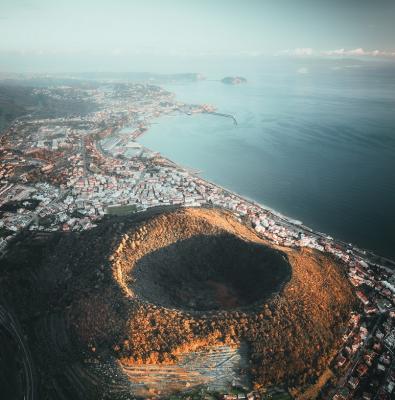Quake tremor rocks Pozzuoli, strongest in 40 years

POZZUOLI – An earthquake tremor measured at 4.2 on the Richter scale rocked this southern seaside town for several seconds and awoke thousands of residents in the nearby city of Naples Wednesday morning, seismologists said. Pozzuoli has felt a series of earth tremors in recent weeks but the one that ripped through the town at 3:35 a.m. from an epicentre 3 km deep was the strongest in 40 years and was felt as far away as Rome, they said. The so-called 'Fiery Fields' at Pozzuoli have long been regarded by scientists as more unstable than the brooding volcano of Vesuvius overlooking the bay of Naples.
Nobody was hurt but many people left their beds and went into the street while civil protection teams were examining buildings in the Coroglio district of Naples where plaster fell off walls of buildings and also were checking the condition of school buildings.
Periods of bradyseism or the gradual uplift (positive bradyseism) or descent (negative bradyseism) of part of the Earth’s surface are not new to the area. Years ago, geologists noticed that holes made by molluscs on the Tempio di Serapide registered up to 6 or 7 M above water. The drastic elevation of the holes proved huge variations in sea and ground levels.
In an extended period stretching from 1982-1983, high earth movement values signalling serious volcanic eruption danger were registered.
In 1538, Monte Nuovo erupted, destroying the nearby town of Tripergole. Luckily, a speedy evacuation of the area led to just a few deaths for those who stubbornly insisted on staying in homes.
Once on site along the stretch of land leading to Nisida, it is still hard to fathom summer bathers are soaking in the sun on seismic ground. In a volcanic district, registering thousands of movements none of which are ever in the same location, there are not any obvious volcanic-shaped geological formations to give people a sense of worry or alarm.
“There is huge underestimation here of the perception one gets from classic volcanoes, like the Vesuvius. This is another of the major problems we have to contend with. Although there’s no resemblance of a volcano here, we are stepping on one now,” says Geologist Vincenzo Morra, indicating the entire seismic area delineating Pozzuoli, Bacoli and Monte di Procida.
As one of the eight science departments that employ 53 professionals qualified in different disciplines, part of the highly qualified technical staff works at the Vesuvius Observatory (INGV- National Institute of Geophysics and Volcanology) located in Campi Flegrei. They obtain information at a technical level and signal any alerting numbers to the Civil Defence that might be dangerous for inhabitants in the surrounding area.
Solfatara, from late Latin Sulpha Terra meaning land of sulphur) is a site where you can visit boiling water up close with its vapours and steaming mud, and is one of the main attractions of the Phlegrean Fields. Known for its characteristically strong rotten egg-like smell, the earth, tormented by fire, creates surreal scenes of unimaginable colours displaying dramatic geysers, springs of gas, and bursts of hot mud and seismic tremors.
In 2017 three tourists from a Turin family were killed when they fell into the crater at Solfatara.
jp
© COPYRIGHT ITALIAN INSIDER
UNAUTHORISED REPRODUCTION FORBIDDEN


